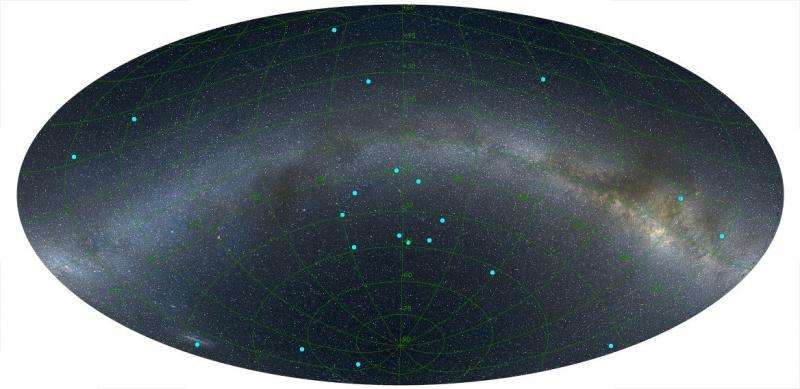September 7, 2015 report
Surprising giant ring-like structure in the universe

(Phys.org)—Five billion light years is a distance almost inconceivable, even on a cosmic scale. To better illustrate the extent of this physical quantity, it's enough to say that 35,000 galaxies the size of our Milky Way are needed to cover that distance. Thanks to a surprising discovery made by a Hungarian-U.S. team of astronomers, now we know that a structure this big really exists in the observable universe.
The researchers found a ring of nine gamma ray bursts (GRBs)—the most luminous events in the universe—about 5 billion light years in diameter, and having a nearly regular circular shape, noting that there is a one in 20,000 probability of the GRBs being in this distribution by chance. They published their findings on July 27 in the Monthly Notices of the Royal Astronomical Society.
Lajos Balazs of Konkoly Observatory in Budapest, Hungary who led the team of astronomers, cannot hide how surprised he was when a feature so large was discovered.
"Until now GRBs are the only objects for which we know the spatial distribution in the whole observable universe. All other objects are complete only in a restricted part of the sky. Our discovery has revealed a large-scale regular feature not known before. Large scale objects like GRB groups have been known already, but such a regular circular structure was a surprise," Balazs told Phys.org.
The newly-found ring-shaped feature is large enough to contradict the cosmological principle (CP), which sets a theoretical limit of 1.2 billion light years for the largest structures. The researchers assume that the ring could be a projection of a spheroidal structure and we see it nearly face-on because of the small variations of GRB distances around the object's center.
Although they claim to have found evidence for a regular structure, the apparent shape of this ring is based only on a visual impression.
The astronomers conclude that the ring is probably not a real physical structure. But further studies are needed to reveal whether or not the structure could have been produced by a low-frequency spatial harmonic of the large-scale matter density distribution or of universal star-forming activity.
"It would be important to increase the number of GRBs with known redshift, consequently with known distances, and to study the distribution of galaxies potentially hosting GRBs in more detail," Balazs said.
GRBs are the brightest electromagnetic events known to occur in the universe. They release as much energy in a few seconds as the Sun does over its 10-billion-year lifetime. GRBs are believed to be the result of massive stars collapsing into black holes. But the problem of forming GRBs is still not completely settled.
"According to the widely accepted view, the GRBs have two basic types. The short duration ones, less than a couple of seconds, are formed by two coalescing neutron stars, while the longer ones resulted in collapsing stars of 20 to 40 solar masses," Balazs revealed.
The majority of the observed GRBs are resulted in collapsing high-mass stars. GRBs are very rare transient phenomena. Consequently, the observed spatial distribution is a serious under-sampling of the space distribution of galaxies in general. Furthermore, the high-mass stars have short lifetimes; thus, GRBs prefer those galaxy hosts having considerable star-forming activity.
The known number of GRBs now exceeds a couple of thousand and is steadily increasing with ongoing observations.
More information: A giant ring-like structure at 0.78 <� z <� 0.86 displayed by GRBs, MNRAS (September 21, 2015) 452 (3): 2236-2246. DOI: 10.1093/mnras/stv1421
Abstract
According to the cosmological principle (CP), Universal large-scale structure is homogeneous and isotropic. The observable Universe, however, shows complex structures even on very large scales. The recent discoveries of structures significantly exceeding the transition scale of 370 Mpc pose a challenge to the CP. We report here the discovery of the largest regular formation in the observable Universe; a ring with a diameter of 1720 Mpc, displayed by 9 gamma-ray bursts (GRBs), exceeding by a factor of 5 the transition scale to the homogeneous and isotropic distribution. The ring has a major diameter of 43° and a minor diameter of 30° at a distance of 2770 Mpc in the 0.78 <� z <� 0.86 redshift range, with a probability of 2 × 10−6 of being the result of a random fluctuation in the GRB count rate. Evidence suggests that this feature is the projection of a shell on to the plane of the sky. Voids and string-like formations are common outcomes of large-scale structure. However, these structures have maximum sizes of 150 Mpc, which are an order of magnitude smaller than the observed GRB ring diameter. Evidence in support of the shell interpretation requires that temporal information of the transient GRBs be included in the analysis. This ring-shaped feature is large enough to contradict the CP. The physical mechanism responsible for causing it is unknown.
Journal information: Monthly Notices of the Royal Astronomical Society
© 2015 Phys.org




















